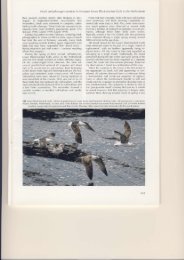Identification of American Herring Gull in a western European context
Identification of American Herring Gull in a western European context
Identification of American Herring Gull in a western European context
Create successful ePaper yourself
Turn your PDF publications into a flip-book with our unique Google optimized e-Paper software.
<strong>Identification</strong> <strong>of</strong> <strong>American</strong> <strong>Herr<strong>in</strong>g</strong> <strong>Gull</strong> <strong>in</strong> a <strong>western</strong> <strong>European</strong> <strong>context</strong>555657 5855 <strong>American</strong> <strong>Herr<strong>in</strong>g</strong> <strong>Gull</strong> / Amerikaanse Zilvermeeuw Larus smithsonianus, second-w<strong>in</strong>ter, Boston, Massachusetts,USA, January 2001 (Pat Lonergan). Another difficult <strong>in</strong>dividual but note dark lower h<strong>in</strong>dneck and tertials.56 <strong>American</strong> <strong>Herr<strong>in</strong>g</strong> <strong>Gull</strong> / Amerikaanse Zilvermeeuw Larus smithsonianus, second-w<strong>in</strong>ter, Boston, Massachusetts,USA, January 1998 (Pat Lonergan)57 <strong>European</strong> <strong>Herr<strong>in</strong>g</strong> <strong>Gull</strong> / Zilvermeeuw Larus argentatus argenteus, second-w<strong>in</strong>ter, Dubl<strong>in</strong>, Ireland, 30 December1999 (Killian Mullarney). Most second-w<strong>in</strong>ter <strong>European</strong> <strong>Herr<strong>in</strong>g</strong> <strong>Gull</strong>s are rather sparsely marked on underparts,especially undertail-coverts, compared with most <strong>American</strong> <strong>Herr<strong>in</strong>g</strong> <strong>Gull</strong>s L smithsonianus <strong>of</strong> same age.58 <strong>European</strong> <strong>Herr<strong>in</strong>g</strong> <strong>Gull</strong> / Zilvermeeuw Larus argentatus, first-summer/second-w<strong>in</strong>ter, Wexford, Ireland,27 August 1997 (Killian Mullarney). Note dark, smithsonianus-like tertials.Primary pattern Like argenteus, but <strong>in</strong> contrast to am<strong>in</strong>ority <strong>of</strong> argentatus, most second-w<strong>in</strong>ter smithsonianuslack a mirror on p10.Underw<strong>in</strong>g-coverts On average, more solidly darkthan <strong>in</strong> <strong>European</strong> <strong>Herr<strong>in</strong>g</strong> <strong>Gull</strong>s.Greater coverts Slightly darker and more uniform (lessbarred) than <strong>in</strong> <strong>European</strong> <strong>Herr<strong>in</strong>g</strong> <strong>Gull</strong>, although thereis considerable overlap.Upperparts a Those birds with entirely or mostly patternedupperparts, <strong>of</strong>ten show less regular barr<strong>in</strong>g herethan <strong>European</strong> <strong>Herr<strong>in</strong>g</strong> <strong>Gull</strong>s. The pattern <strong>of</strong> the secondw<strong>in</strong>terscapulars <strong>in</strong> smithsonianus is highly variable and<strong>European</strong> <strong>Herr<strong>in</strong>g</strong> <strong>Gull</strong>s can match most patterns, sothese are <strong>of</strong> little help <strong>in</strong> identification. However, a fewbirds have scapulars that are rather pla<strong>in</strong> with a more orless broad dark shaft-streak (plate 42, 43 and 54),creat<strong>in</strong>g an overall pattern that we do not recognize asbe<strong>in</strong>g with<strong>in</strong> the normal range <strong>of</strong> variation exhibited by<strong>European</strong> <strong>Herr<strong>in</strong>g</strong> <strong>Gull</strong>; b those with entirely or mostlygrey (adult-like) upperparts may <strong>of</strong>ten show a strongcontrast between the pale ‘saddle’ and surround<strong>in</strong>g darkh<strong>in</strong>dneck, underparts and w<strong>in</strong>g-coverts.Third-w<strong>in</strong>ter (plate 59-72)As <strong>in</strong>dicated earlier, the proportion <strong>of</strong> identifiablebirds decreases sharply with <strong>in</strong>creas<strong>in</strong>g age.However, there are characters shown by some(perhaps 40-50%) third-w<strong>in</strong>ter smithsonianusthat appear to be diagnostic. In practice, tell<strong>in</strong>gsecond-w<strong>in</strong>ter from third-w<strong>in</strong>ter ‘herr<strong>in</strong>g gulls’ isnot always easy; different parts <strong>of</strong> the bird, for<strong>in</strong>stance, the tail, body, w<strong>in</strong>g-coverts and bill donot necessarily develop at the same rate, so abird with an ‘advanced’ tail pattern, for its age,might have a ‘retarded’ bill pattern. Most thirdw<strong>in</strong>terswill have a more advanced w<strong>in</strong>g pattern21










